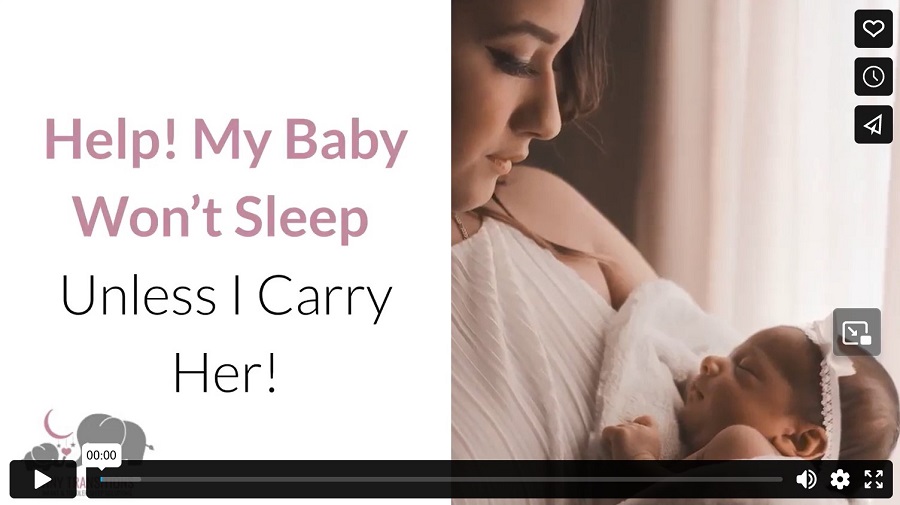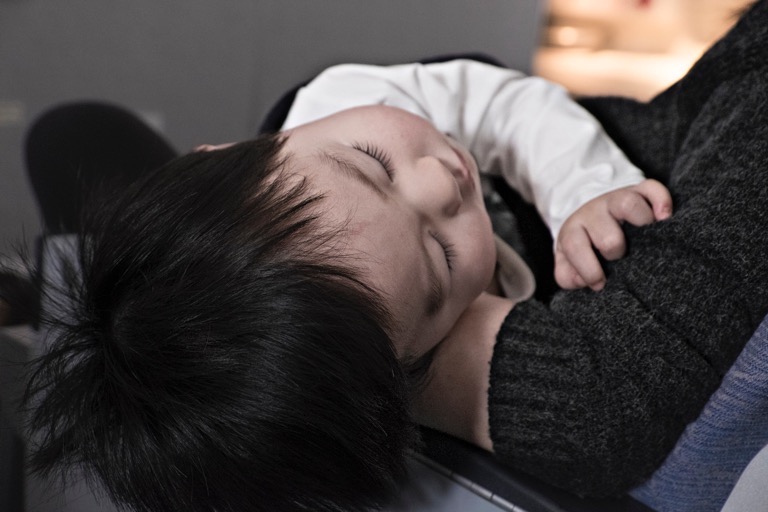Most parents have been there: you have just walked the equivalent of a half-marathon around your living room carrying the baby, and she’s finally (FINALLY!) asleep. You put her down as gently as you can, but before you can say “Rumpelstiltskin!” her eyes pop open, and she starts to wail.
When you have to carry your baby to get her/keep her asleep, you can feel like a prisoner in your own home. You can’t get anything done, and you never get alone time to recharge the batteries. It feels like someone is touching you 24/7, which is exhausting in its own right. You also know that the baby isn’t sleeping as well or as long as she could be if she were in a crib, and frankly, holding a sleeping baby when you’re tired is unsafe. So what can you do?
Every baby is different, so there isn’t necessarily a right or wrong answer. You will need to do a little experimentation to see what works best to teach your baby to sleep alone, but we’ve compiled a list of four things to try.
1. Be Patient
Really young babies are simply incapable of calming themselves down, so you just need to be patient. We know: easier said than done when you are so sleep-deprived. During the newborn stage, give that little baby snuggles and kisses and soft caresses whenever she cries until she gets to be a little older and can calm herself. Newborn-ness is so fleeting that it’s important to get that bonding time in when you can. Work on self-calming techniques during the daylight hours, and eventually, she’ll start doing them at night when she wakes up. For now, when your newborn cries, it’s ok to calm her down by picking her up and rocking her.
2. Wait a Moment
Whether you are a proponent of the Cry It Out (CIO) method, the Ferber method, the Chair method, or (insert other method here), one way to help your baby become comfortable in her bed is to wait a moment when she cries. You might want to rush in and soothe her immediately after she starts fussing in her bed (certain parts of you might literally be *aching* to get her to stop crying…), but pause for a moment. If she’s safe in her bed, letting her fuss for a moment or two before you get her helps her become used to the idea of the crib as a safe place.
3. Be Discerning
Depending on your bedtime routine habits, falling asleep in your arms might just be the most comfortable way for your baby to go to bed. Your smell, warmth, and gentle touches are calming and comforting – who wouldn’t want to go to sleep that way?
Sometimes it’s ok to rock your baby to sleep – the power of knowing what your baby needs is one of the gifts that accompany parenthood. The thing is, older babies need to learn the skill for falling asleep on their own eventually.
Before you try any style of sleep training, however, make sure that your baby is getting the right amount of sleep during the day to make nighttime sleep training worthwhile. Pay attention to her sleep cues and adjust your tactics accordingly. Remember: being overtired is the main reason for poor sleep and ineffective sleep training. You may need to modify schedules and hold your baby for daytime naps, but with time and consistency, your baby will learn how to sleep on her own both at night and during the day.
4. To Swaddle or Not to Swaddle?
Swaddling has become somewhat controversial in recent years. When you swaddle a baby, you are tightly wrapping her arms to her body in a way that mimics her being back in utero. This tight, warm position is calming to most babies and can help subdue the startle reflex that often creates frustratingly short naps. Babies suffering from withdrawal or other health concerns particularly benefit from swaddling because their startle reflex tends to be on high alert.
The problem with swaddling is that certain research shows that it can increase the risk of Sudden Infant Death Syndrome (SIDS). The exact connection between swaddling and SIDS is unclear because SIDS is such an elusive and individual diagnosis. When swaddled, it’s possible that the babies become too warm, can’t breathe as well, or sleep so deeply they can’t wake up. Most of the cases, however, found that the swaddled baby had rolled onto her back or side and subsequently couldn’t breathe. For this reason, many pediatricians recommend a few options:
- Skip swaddling altogether
o Instead, use a special, loose-fitting sleep sack that still reduces the startle reflex - Swaddle until the baby falls asleep then unswaddle
- If you do choose to swaddle
o NEVER place baby on side or stomach
o Use a lightweight blanket that is tight enough around the arms to prevent unraveling but loose enough that you can fit a finger easily inside
o Keep the swaddle around the hips loose to prevent hip dysplasia
o Keep all swaddling blankets or devices away from the baby’s face
o ALWAYS stop swaddling when the baby starts trying to roll over – some pediatricians suggest stopping swaddling no later than eight weeks old or latest at four months
In the end, the decision to swaddle is between you and your baby’s pediatrician, but it is important to know the current research behind swaddling and its link to SIDS.
Being tired and having a tired baby is a lose-lose situation. If you are at your wit’s end and have tried everything you can think of, contact one of our certified sleep consultants today. We approach sleep training with a compassionate and gentle approach tailor to meet both of your needs.
And if you are looking to be a sleep coach yourself, contact us. We offer the only Sleep Consultant Certification and Business Coaching Course created to make you the premier baby sleep consultant in your area. If you know how life-changing sleep is for families with children and are looking to build a career that changes lives by helping people families adopt the best sleep practices, we’re here to help. Our program won’t just teach you the basics and send you out the door. Rather, we offer six months of intensive business and sleep coaching certification and guide you as you define and grow your business.
Video



